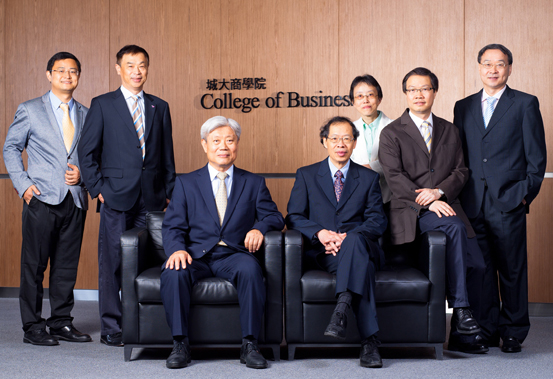The rising cost of healthcare is a concern for governments around the world, with aging populations consuming an ever greater proportion of GDP. At the same time health services are often vigorously defended, many seeing them as an essential pillar of society. In Hong Kong the healthcare services are cherished, and now advances in database technology mean that real progress can be made in delivering a flexible and efficient system. This opportunity is to be leveraged in an ambitious project Delivering 21st Century Healthcare in Hong Kong – Building a Quality-and-Efficiency Driven System, recently approved by the Hong Kong Research Grants Council.
From left: Dr Yanzhi Li, Professor Houmin Yan, Professor Jeong-Bon Kim, Professor Yer Van Hui, Dr Carrie Lin, Professor Kelvin Yau, and Professor Frank Chen of the research team
"We aim to help develop an efficient, quality-driven healthcare delivery system in Hong Kong that is built upon data analytics and is compatible with the internet age", says Project Coordinator Professor Frank Chen, Head of CB's Department of Management Sciences.
The Theme-based Research Scheme is led by the College of Business working in collaboration with Chinese University of Hong Kong, Hong Kong Polytechnic University, Hong Kong University of Science and Technology, Lingnan University, University of Hong Kong, as well as Columbia University in the United States and Curtin University in Australia, and is supported by a grant of HK$20.45 million.
Delivering 21st Century Healthcare plans to research and provide recommendations in three areas: operations research into hospital resource planning, healthcare data management, and more long-term population healthcare life-cycle studies.
Healthcare is hot
"Healthcare is a hot topic all over the world", Professor Chen continues. "In the US it's taking over 17% of GDP, in the UK and Australia it's over 9%, so governments have the motive to act."
In Hong Kong healthcare costs equate to just over 3% of GDP – and less than half of that goes on the public healthcare system. But with an aging population, bills are set to soar. Any efficiencies that new technology can deliver are eagerly anticipated.
"Our research plan calls for in-depth studies on applying data analytics technologies to help deliver better care at affordable cost," says Professor Chen.
The American connection is important. The US National Science Foundation (NSF) recently organized a task force to identify Grand Challenges for the next ten years, and the health care sector came out as a top priority. The Chair of the NSF Health sub-committee was Professor David Yao, of Columbia University, who is also a Co-Principal Investigator on this project.
"Professor Yao is probably the mastermind of the project, he's the one who had experience of healthcare research papers in China and Singapore, and he came up with the concept," says Professor Chen.
How about specific problems in Hong Kong health care?
"Health management, as opposed to clinical research, has been historically under-researched in Hong Kong. So there's a great opportunity to contribute to the sector," says Professor Chen.
"Due to zoning issues in Hong Kong waiting times are very uneven. The median waiting time for non-urgent outpatients in the Kowloon East cluster is 60 weeks, compared to just seven weeks in Hong Kong West!"
The project also owes much to the experience of Advisory Board members Professor EK Yeoh, formerly Secretary for Health, Welfare and Food of the Government of the HKSAR, and Professor Hong Fung, formerly Cluster Chief Executive of the New Territories East at the Hospital Authority. With such senior figures on board, it is hoped that the doors to interdisciplinary research will be opened, practical matters of coordination boosted, and access to data facilitated.
Predictive analytics
The big new game in town is predictive analytics. The idea is that when things occur they don't do so all at once but gradually over time. Correlational analysis can identify the specific patterns that occur before, for example, something breaks. This is as true for industrial systems such as car maintenance as it is for the human body. A well known example is Google flu. Google discovered that certain search terms are good indicators of flu activity. Google Flu Trends uses aggregated Google search data to estimate current flu activity around the world in near real-time.
Note the 'near real time.' In the old days a health authority would aggregate and publish data perhaps once a month, reporting after the event. Nowadays statistics are being released online before the event.
This kind of predictive analytics technology first became prominent in marketing. For years sites such as Amazon have offered their users analysis such as: Customers who viewed this item also viewed… The technology behind this system is based on a patent for item to item collaborative filtering, and dates back to 1998. It doesn't need to compare people with other people. It just needs to find associations between items themselves. Today it is estimated that about one third of all Amazon's sales are the result of its recommendation and personalization system.
Linked databases
The same methodology can be applied to other sectors such as health or safety, but the analysis can only be worked if the databases are linked in a usable way. Co-Principal Coordinator Professor Kelvin Yau, has been working on health and safety projects, albeit with somewhat projectspecific databases, for the last ten years or so.
"As a first attempt, we started searching publicly accessible Hong Kong traffic accident data to try and examine the interrelationship between accident incidence/severity/pattern and a set of human/vehicle/environmental factors. We have experienced difficulty in that the data cannot be effectively linked, and therefore the outcome cannot be corresponded to the explanatory variables, which limits further exploration on the substantive issues on traffic safety in a multifaceted way."
"At the moment Hong Kong government departments have all got their own separate databases. In some countries such as Australia the government has taken the initiative to link databases. It would be very helpful if the Hong Kong government could take the lead and establish a similar linked database, of course with deidentified personal data," Professor Yau added.
The health sector is producing Big Data on an industrial scale – somewhat similar to Google, Amazon or eBay. And academia is responding. In 2013 researchers worldwide published approximately the same number of papers on using prediction in healthcare as were published in the entire 1990s. In Hong Kong, Professor Chen and his team are sitting on a gold mine. The Hospital Authority and her cluster hospitals accrue large quantities of data on a daily basis simply as a part of doing their regular business. The big question is how far can this rich data source be exploited here in Hong Kong?
Individual privacy: at what price?
The question revolves around the issue of risk management: how to balance individual privacy rights with the collective rights to an efficient quality health system, and this is something that concerns organisations worldwide.
The Organisation for Economic Co-operation and Development (OECD) has spent a lot of time looking at this issue in the last few years. With 34 member countries, not surprisingly there are significant differences in the extent to which personal health data may be collected, linked and analysed. Many countries report legislative barriers to the use of personal health data. The OECD has concluded that a risk classification of data and data uses is needed to identify cases of higher risk to patient's information privacy.
Goldmine waiting to be tapped
As College of Business Dean Houmin Yan, Project Co-Principal Investigator says:
"We have been working with driving efficiency in business systems in the past. Now with healthcare systems, it has to be quality and efficiency focused, human centric, and fairness driven. As far as large volumes of healthcare data are concerned, the goldmine is there. The issue is how we can identify and use the relevant data."
Areas that the project will work on include networked hospital resource planning and management, public-private partnerships, patient flow management, multidimensional mining of healthcare data, and risk-adjustment methods.
Thanks to a unique combination of factors, Hong Kong healthcare is on the cusp of a new era. This ambitious project, very much in the tradition of applied CB research projects which aim to improve the quality of ordinary citizen's lives, looks set to make a significant contribution to healthcare services in Hong Kong.
The 2012 London Olympics Opening Ceremony celebrates the Great Ormond Street Children's Hospital, part of the National Healthcare service in the United Kingdom.


